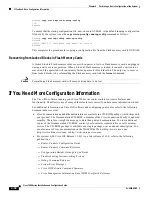
4-19
Cisco 7500 Series Installation and Configuration Guide
OL-5008-03 B0
Chapter 4 Performing a Basic Configuration of the System
Implementing Other Configuration Tasks
Checking the Settings
You can check the value of the settings you entered by entering either of the following commands at the
# prompt:
•
show running-config (if you are running Cisco IOS Release 11.0 or later)
•
write terminal (if you are running a Cisco IOS release earlier than Release 11.0)
Following is an example:
Router# show running-config
.
.
.
Saving the Settings to NVRAM and Reviewing Your Configuration
To store the configuration or changes to your startup configuration, enter the following commands at the
hostname#
prompt:
•
copy running-config startup-config (if you are running Cisco IOS Release 11.0 or later)
•
write memory (if you are running a Cisco IOS release earlier than Release 11.0)
Following is an example:
Hostname# copy running-config startup-config
Entering these commands will save the configuration settings that you created in the router using
configuration mode. If you fail to do this, your configuration will be lost the next time you reload the
router.
To display information stored in NVRAM, use the show startup-config EXEC command if you are
running Cisco IOS Release 11.0 or later, or the show config EXEC command if you are running a Cisco
IOS release earlier than Release 11.0.
Implementing Other Configuration Tasks
After you establish the basic startup configuration for your router, if you need to make more advanced
configuration changes, see the
“If You Need More Configuration Information” section on page 4-32
for
a list of the appropriate configuration publications.
These publications contain additional information on using the configure command and provide
additional information about the following tasks:
•
Understanding and working with the user interface on your router
•
Booting and rebooting the router
•
Setting the configuration register
•
Loading configuration files or system images using remote copy (rcp) or Trivial File Transfer
Protocol (TFTP)
•
Reloading the operating system



































